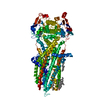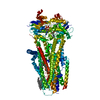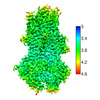[English] 日本語
 Yorodumi
Yorodumi- EMDB-43014: Phosphorylated, ATP-bound, inhibitor 172-bound E1371Q human cysti... -
+ Open data
Open data
- Basic information
Basic information
| Entry |  | |||||||||
|---|---|---|---|---|---|---|---|---|---|---|
| Title | Phosphorylated, ATP-bound, inhibitor 172-bound E1371Q human cystic fibrosis transmembrane conductance regulator | |||||||||
 Map data Map data | ||||||||||
 Sample Sample |
| |||||||||
 Keywords Keywords | cystic fibrosis / chloride channel / hydrolysis-deficient mutant / MEMBRANE PROTEIN-INHIBITOR complex | |||||||||
| Function / homology |  Function and homology information Function and homology informationpositive regulation of voltage-gated chloride channel activity / positive regulation of cyclic nucleotide-gated ion channel activity / Sec61 translocon complex binding / channel-conductance-controlling ATPase / intracellularly ATP-gated chloride channel activity / positive regulation of enamel mineralization / transepithelial water transport / RHO GTPases regulate CFTR trafficking / intracellular pH elevation / amelogenesis ...positive regulation of voltage-gated chloride channel activity / positive regulation of cyclic nucleotide-gated ion channel activity / Sec61 translocon complex binding / channel-conductance-controlling ATPase / intracellularly ATP-gated chloride channel activity / positive regulation of enamel mineralization / transepithelial water transport / RHO GTPases regulate CFTR trafficking / intracellular pH elevation / amelogenesis / chloride channel inhibitor activity / ATPase-coupled inorganic anion transmembrane transporter activity / Golgi-associated vesicle membrane / multicellular organismal-level water homeostasis / cholesterol transport / membrane hyperpolarization / vesicle docking involved in exocytosis / bicarbonate transport / bicarbonate transmembrane transporter activity / chloride channel regulator activity / chloride transmembrane transporter activity / sperm capacitation / chloride channel activity / cholesterol biosynthetic process / RHOQ GTPase cycle / positive regulation of exocytosis / positive regulation of insulin secretion involved in cellular response to glucose stimulus / chloride channel complex / ATPase-coupled transmembrane transporter activity / ABC-type transporter activity / cellular response to cAMP / cellular response to forskolin / chloride transmembrane transport / response to endoplasmic reticulum stress / isomerase activity / clathrin-coated endocytic vesicle membrane / establishment of localization in cell / PDZ domain binding / Defective CFTR causes cystic fibrosis / Late endosomal microautophagy / ABC-family proteins mediated transport / recycling endosome / transmembrane transport / Aggrephagy / Chaperone Mediated Autophagy / recycling endosome membrane / Cargo recognition for clathrin-mediated endocytosis / Clathrin-mediated endocytosis / early endosome membrane / protein-folding chaperone binding / endosome membrane / early endosome / Ub-specific processing proteases / apical plasma membrane / lysosomal membrane / endoplasmic reticulum membrane / enzyme binding / cell surface / ATP hydrolysis activity / protein-containing complex / ATP binding / membrane / nucleus / plasma membrane / cytoplasm / cytosol Similarity search - Function | |||||||||
| Biological species |  Homo sapiens (human) Homo sapiens (human) | |||||||||
| Method | single particle reconstruction / cryo EM / Resolution: 3.6 Å | |||||||||
 Authors Authors | Gao X / Hwang T | |||||||||
| Funding support |  United States, 2 items United States, 2 items
| |||||||||
 Citation Citation |  Journal: Nat Commun / Year: 2024 Journal: Nat Commun / Year: 2024Title: Allosteric inhibition of CFTR gating by CFTRinh-172 binding in the pore. Authors: Xiaolong Gao / Han-I Yeh / Zhengrong Yang / Chen Fan / Fan Jiang / Rebecca J Howard / Erik Lindahl / John C Kappes / Tzyh-Chang Hwang /    Abstract: Loss-of-function mutations of the CFTR gene cause the life-shortening genetic disease cystic fibrosis (CF), whereas overactivity of CFTR may lead to secretory diarrhea and polycystic kidney disease. ...Loss-of-function mutations of the CFTR gene cause the life-shortening genetic disease cystic fibrosis (CF), whereas overactivity of CFTR may lead to secretory diarrhea and polycystic kidney disease. While effective drugs targeting the CFTR protein have been developed for the treatment of CF, little progress has been made for diseases caused by hyper-activated CFTR. Here, we solve the cryo-EM structure of CFTR in complex with CFTRinh-172 (Inh-172), a CFTR gating inhibitor with promising potency and efficacy. We find that Inh-172 binds inside the pore of CFTR, interacting with amino acid residues from transmembrane segments (TMs) 1, 6, 8, 9, and 12 through mostly hydrophobic interactions and a salt bridge. Substitution of these residues lowers the apparent affinity of Inh-172. The inhibitor-bound structure reveals re-orientations of the extracellular segment of TMs 1, 8, and 12, supporting an allosteric modulation mechanism involving post-binding conformational changes. This allosteric inhibitory mechanism readily explains our observations that pig CFTR, which preserves all the amino acid residues involved in Inh-172 binding, exhibits a much-reduced sensitivity to Inh-172 and that the apparent affinity of Inh-172 is altered by the CF drug ivacaftor (i.e., VX-770) which enhances CFTR's activity through binding to a site also comprising TM8. | |||||||||
| History |
|
- Structure visualization
Structure visualization
| Supplemental images |
|---|
- Downloads & links
Downloads & links
-EMDB archive
| Map data |  emd_43014.map.gz emd_43014.map.gz | 4.9 MB |  EMDB map data format EMDB map data format | |
|---|---|---|---|---|
| Header (meta data) |  emd-43014-v30.xml emd-43014-v30.xml emd-43014.xml emd-43014.xml | 16.8 KB 16.8 KB | Display Display |  EMDB header EMDB header |
| FSC (resolution estimation) |  emd_43014_fsc.xml emd_43014_fsc.xml | 9.3 KB | Display |  FSC data file FSC data file |
| Images |  emd_43014.png emd_43014.png | 132.5 KB | ||
| Filedesc metadata |  emd-43014.cif.gz emd-43014.cif.gz | 6.7 KB | ||
| Others |  emd_43014_half_map_1.map.gz emd_43014_half_map_1.map.gz emd_43014_half_map_2.map.gz emd_43014_half_map_2.map.gz | 52.1 MB 52.1 MB | ||
| Archive directory |  http://ftp.pdbj.org/pub/emdb/structures/EMD-43014 http://ftp.pdbj.org/pub/emdb/structures/EMD-43014 ftp://ftp.pdbj.org/pub/emdb/structures/EMD-43014 ftp://ftp.pdbj.org/pub/emdb/structures/EMD-43014 | HTTPS FTP |
-Validation report
| Summary document |  emd_43014_validation.pdf.gz emd_43014_validation.pdf.gz | 690.7 KB | Display |  EMDB validaton report EMDB validaton report |
|---|---|---|---|---|
| Full document |  emd_43014_full_validation.pdf.gz emd_43014_full_validation.pdf.gz | 690.3 KB | Display | |
| Data in XML |  emd_43014_validation.xml.gz emd_43014_validation.xml.gz | 16.3 KB | Display | |
| Data in CIF |  emd_43014_validation.cif.gz emd_43014_validation.cif.gz | 21.1 KB | Display | |
| Arichive directory |  https://ftp.pdbj.org/pub/emdb/validation_reports/EMD-43014 https://ftp.pdbj.org/pub/emdb/validation_reports/EMD-43014 ftp://ftp.pdbj.org/pub/emdb/validation_reports/EMD-43014 ftp://ftp.pdbj.org/pub/emdb/validation_reports/EMD-43014 | HTTPS FTP |
-Related structure data
| Related structure data |  8v81MC  8v7zC C: citing same article ( M: atomic model generated by this map |
|---|---|
| Similar structure data | Similarity search - Function & homology  F&H Search F&H Search |
- Links
Links
| EMDB pages |  EMDB (EBI/PDBe) / EMDB (EBI/PDBe) /  EMDataResource EMDataResource |
|---|---|
| Related items in Molecule of the Month |
- Map
Map
| File |  Download / File: emd_43014.map.gz / Format: CCP4 / Size: 67 MB / Type: IMAGE STORED AS FLOATING POINT NUMBER (4 BYTES) Download / File: emd_43014.map.gz / Format: CCP4 / Size: 67 MB / Type: IMAGE STORED AS FLOATING POINT NUMBER (4 BYTES) | ||||||||||||||||||||
|---|---|---|---|---|---|---|---|---|---|---|---|---|---|---|---|---|---|---|---|---|---|
| Voxel size | X=Y=Z: 1.069 Å | ||||||||||||||||||||
| Density |
| ||||||||||||||||||||
| Symmetry | Space group: 1 | ||||||||||||||||||||
| Details | EMDB XML:
|
-Supplemental data
-Half map: #2
| File | emd_43014_half_map_1.map | ||||||||||||
|---|---|---|---|---|---|---|---|---|---|---|---|---|---|
| Projections & Slices |
| ||||||||||||
| Density Histograms |
-Half map: #1
| File | emd_43014_half_map_2.map | ||||||||||||
|---|---|---|---|---|---|---|---|---|---|---|---|---|---|
| Projections & Slices |
| ||||||||||||
| Density Histograms |
- Sample components
Sample components
-Entire : E1371Q-CFTR
| Entire | Name: E1371Q-CFTR |
|---|---|
| Components |
|
-Supramolecule #1: E1371Q-CFTR
| Supramolecule | Name: E1371Q-CFTR / type: complex / ID: 1 / Parent: 0 / Macromolecule list: #1 |
|---|---|
| Source (natural) | Organism:  Homo sapiens (human) Homo sapiens (human) |
-Macromolecule #1: Cystic fibrosis transmembrane conductance regulator
| Macromolecule | Name: Cystic fibrosis transmembrane conductance regulator / type: protein_or_peptide / ID: 1 / Number of copies: 1 / Enantiomer: LEVO / EC number: channel-conductance-controlling ATPase |
|---|---|
| Source (natural) | Organism:  Homo sapiens (human) Homo sapiens (human) |
| Molecular weight | Theoretical: 163.494078 KDa |
| Recombinant expression | Organism:  |
| Sequence | String: RSPLEKASVV SKLFFSWTRP ILRKGYRQRL ELSDIYQIPS VDSADNLSEK LEREWDRELA SKKNPKLINA LRRCFFWRFM FYGIFLYLG EVTKAVQPLL LGRIIASYDP DNKEERSIAI YLGIGLCLLF IVRTLLLHPA IFGLHHIGMQ MRIAMFSLIY K KTLKLSSR ...String: RSPLEKASVV SKLFFSWTRP ILRKGYRQRL ELSDIYQIPS VDSADNLSEK LEREWDRELA SKKNPKLINA LRRCFFWRFM FYGIFLYLG EVTKAVQPLL LGRIIASYDP DNKEERSIAI YLGIGLCLLF IVRTLLLHPA IFGLHHIGMQ MRIAMFSLIY K KTLKLSSR VLDKISIGQL VSLLSNNLNK FDEGLALAHF VWIAPLQVAL LMGLIWELLQ ASAFCGLGFL IVLALFQAGL GR MMMKYRD QRAGKISERL VITSEMIENI QSVKAYCWEE AMEKMIENLR QTELKLTRKA AYVRYFNSSA FFFSGFFVVF LSV LPYALI KGIILRKIFT TISFCIVLRM AVTRQFPWAV QTWYDSLGAI NKIQDFLQKQ EYKTLEYNLT TTEVVMENVT AFWE EGFGE LFEKAKQNNN NRKTSNGDDS LFFSNFSLLG TPVLKDINFK IERGQLLAVA GSTGAGKTSL LMVIMGELEP SEGKI KHSG RISFCPQFPW IMPGTIKENI IFGVSYDEYR YRSVIKACQL EEDISKFPEK DNTVLGEGGI TLSGGQRAKI SLARAV YKD ADLYLLDSPF GYLDVLTEKE IFESCVCKLM ANKTRILVTS KMEHLKKADK ILILHEGSSY FYGTFSELQN LQPDFSS KL MGCDSFDQFS AERRNSILTE TLHRFSLEGD APVSWTETKK QSFKQTGEFG EKRKNSILNP INSIRKFSIV QKTPLQMN G IEEDSDEPLE RRLSLVPDSE QGEAILPRIS VISTGPTLQA RRRQSVLNLM THSVNQGQNI HRKTTASTRK VSLAPQANL TELDIYSRRL SQETGLEISE EINEEDLKEC FFDDMESIPA VTTWNTYLRY ITVHKSLIFV LIWCLVIFLA EVAASLVVLW LLGNTPLQD KGNSTHSRNN SYAVIITSTS SYYVFYIYVG VADTLLAMGF FRGLPLVHTL ITVSKILHHK MLHSVLQAPM S TLNTLKAG GILNRFSKDI AILDDLLPLT IFDFIQLLLI VIGAIAVVAV LQPYIFVATV PVIVAFIMLR AYFLQTSQQL KQ LESEGRS PIFTHLVTSL KGLWTLRAFG RQPYFETLFH KALNLHTANW FLYLSTLRWF QMRIEMIFVI FFIAVTFISI LTT GEGEGR VGIILTLAMN IMSTLQWAVN SSIDVDSLMR SVSRVFKFID MPTEGKPTKS TKPYKNGQLS KVMIIENSHV KKDD IWPSG GQMTVKDLTA KYTEGGNAIL ENISFSISPG QRVGLLGRTG SGKSTLLSAF LRLLNTEGEI QIDGVSWDSI TLQQW RKAF GVIPQKVFIF SGTFRKNLDP YEQWSDQEIW KVADEVGLRS VIEQFPGKLD FVLVDGGCVL SHGHKQLMCL ARSVLS KAK ILLLDQPSAH LDPVTYQIIR RTLKQAFADC TVILCEHRIE AMLECQQFLV IEENKVRQYD SIQKLLNERS LFRQA UniProtKB: Cystic fibrosis transmembrane conductance regulator |
-Macromolecule #2: MAGNESIUM ION
| Macromolecule | Name: MAGNESIUM ION / type: ligand / ID: 2 / Number of copies: 2 / Formula: MG |
|---|---|
| Molecular weight | Theoretical: 24.305 Da |
-Macromolecule #3: ADENOSINE-5'-TRIPHOSPHATE
| Macromolecule | Name: ADENOSINE-5'-TRIPHOSPHATE / type: ligand / ID: 3 / Number of copies: 2 / Formula: ATP |
|---|---|
| Molecular weight | Theoretical: 507.181 Da |
| Chemical component information |  ChemComp-ATP: |
-Macromolecule #4: (2S)-3-(hexadecanoyloxy)-2-[(9Z)-octadec-9-enoyloxy]propyl 2-(tri...
| Macromolecule | Name: (2S)-3-(hexadecanoyloxy)-2-[(9Z)-octadec-9-enoyloxy]propyl 2-(trimethylammonio)ethyl phosphate type: ligand / ID: 4 / Number of copies: 5 / Formula: POV |
|---|---|
| Molecular weight | Theoretical: 760.076 Da |
| Chemical component information |  ChemComp-POV: |
-Macromolecule #5: CHOLESTEROL
| Macromolecule | Name: CHOLESTEROL / type: ligand / ID: 5 / Number of copies: 1 / Formula: CLR |
|---|---|
| Molecular weight | Theoretical: 386.654 Da |
| Chemical component information |  ChemComp-CLR: |
-Macromolecule #6: 4-[(Z)-{(3M)-4-oxo-2-sulfanylidene-3-[3-(trifluoromethyl)phenyl]-...
| Macromolecule | Name: 4-[(Z)-{(3M)-4-oxo-2-sulfanylidene-3-[3-(trifluoromethyl)phenyl]-1,3-thiazolidin-5-ylidene}methyl]benzoic acid type: ligand / ID: 6 / Number of copies: 1 / Formula: WG5 |
|---|---|
| Molecular weight | Theoretical: 409.402 Da |
-Experimental details
-Structure determination
| Method | cryo EM |
|---|---|
 Processing Processing | single particle reconstruction |
| Aggregation state | particle |
- Sample preparation
Sample preparation
| Buffer | pH: 7.5 |
|---|---|
| Vitrification | Cryogen name: ETHANE |
- Electron microscopy
Electron microscopy
| Microscope | TFS KRIOS |
|---|---|
| Image recording | Film or detector model: GATAN K3 (6k x 4k) / Average electron dose: 1.31475 e/Å2 |
| Electron beam | Acceleration voltage: 300 kV / Electron source:  FIELD EMISSION GUN FIELD EMISSION GUN |
| Electron optics | Illumination mode: OTHER / Imaging mode: OTHER / Nominal defocus max: 1.8 µm / Nominal defocus min: 1.0 µm |
| Experimental equipment |  Model: Titan Krios / Image courtesy: FEI Company |
 Movie
Movie Controller
Controller







 Z
Z Y
Y X
X


















